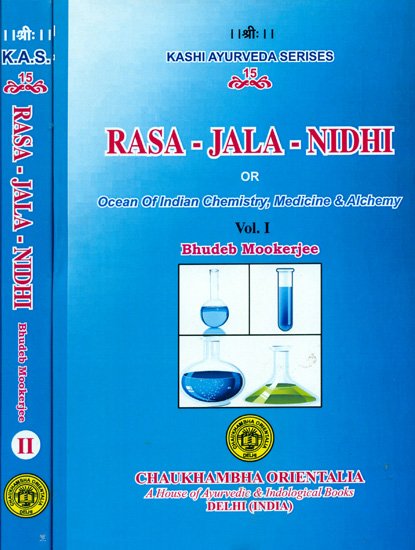Rasa Jala Nidhi, vol 4: Iatrochemistry
by Bhudeb Mookerjee | 1938 | 52,258 words | ISBN-10: 8170305829 | ISBN-13: 9788170305828
This fourth volume of the Rasa-jala-nidhi deals with Rasa-chikitsa-vidya, also known a the science of Iatrchemistry (chemical medicine), a major branch of Ayurveda. It contains Ayurvedic treatments for Fever and Diarrhea. The Rasa-jala-nidhi (“the ocean of Iatrochemistry, or, chemical medicine) is a compendium of Sanskrit verses dealing with ancie...
Part 17 - Advantages of iatro-medical treatment
Such a treatment does not require a detailed examination of the actual state of the three doshas, of the diseases, of countries (resided in by the patient), and of the seasons in which the treatment is undertaken.
Accompaniments of such medicines.
A medicine rapidly spreads all over the body, if mixed with an anupana or accompaniment (which is generally a juice of a herb, honey, clarified butter, etc.), exactly in the same way as oil, thrown upon water, rapidly spreads all over its surface. Juices of herbs, having the required efficacy, selected in due consideration of climate and season, or honey, or only pure water may be used as an accompaniment of medicines prepared mainly from rasa (mercury and other minerals). A few such accompaniments are stated below. Several others may be decided upon by learned physicians. If there is a mention of a special accompaniment in connection with the direction given for the preparation of a particular medicine, that special accompaniment may be used or another accompaniment of equal value may be selected by the physician. In vatodara or in excess of vayu, a medicine is to be taken with the accompaniment of a few drops of honey mixed with one rakti in weight of hingu, fried with clarified butter, and two ractis in weight of jira (cumin-seed), pestled with water. The following are the symptoms of vatodara:—flatulence, belching, pain in the stomach, throbbing below the navel felt by pressure of fingers, and constipation. Hingu should never be used in phthisis. In diarrhoea, any one of these may be used as accompaniment, viz. (a) three ractis in weight of bhanga (canabis sativa), fried with clarified butter, (b) decoction of barch of babbula, (c) decoction of dhanya (coriandrum sativum), mixed with powdered shunthi (dried ginger), and honey. Juices of other herbs, efficacions in diarrhoea may also be used.
In blood dysentery, juice of any one of the following may be given, mixed with a few drops of honey:—kukkuradru, durba grass, leaves of mari-gold, and root of meghanada. Juice or decoction of prasarini is effective in destroying mucus, juice of punarnava in dropsy, of betel leaves in cough and constipation, of leaves of basaka in excess of cough. Similarly, juice or decoction of dhanya and madhurika may be used in excess of pitta in the system, and leaves of shila-bheda in strangury. The accompaniments, mentioned above, should be used with a few drops of fresh honey, which is riot only a medium for mixing medicines but is also a thing which increases the stength of the medicine so mixed with. A medicine is generally to be pestled with its accompaniment and honey, for at least twelve minutes, on a small piece of stone mortar, before it is to be swallowed with the recitation of the aghora mantra or contemplating upon the Deity.
Conclusion:
 This concludes ‘Advantages of iatro-medical treatment’ included in Bhudeb Mookerjee Rasa Jala Nidhi, vol 4: Initiation, Mercury and Laboratory. The text includes treatments, recipes and remedies and is categorised as Rasa Shastra: an important branch of Ayurveda that specialises in medicinal/ herbal chemistry, alchemy and mineralogy, for the purpose of prolonging and preserving life.
This concludes ‘Advantages of iatro-medical treatment’ included in Bhudeb Mookerjee Rasa Jala Nidhi, vol 4: Initiation, Mercury and Laboratory. The text includes treatments, recipes and remedies and is categorised as Rasa Shastra: an important branch of Ayurveda that specialises in medicinal/ herbal chemistry, alchemy and mineralogy, for the purpose of prolonging and preserving life.
